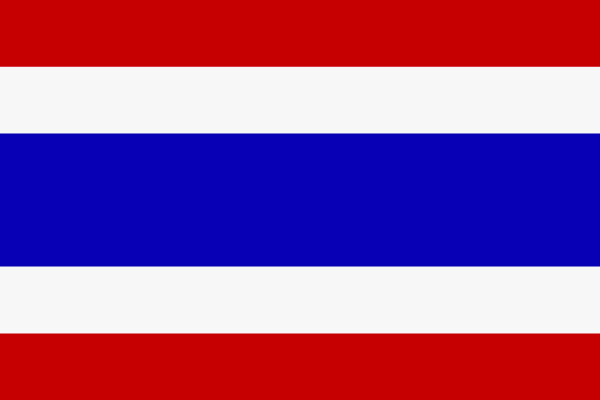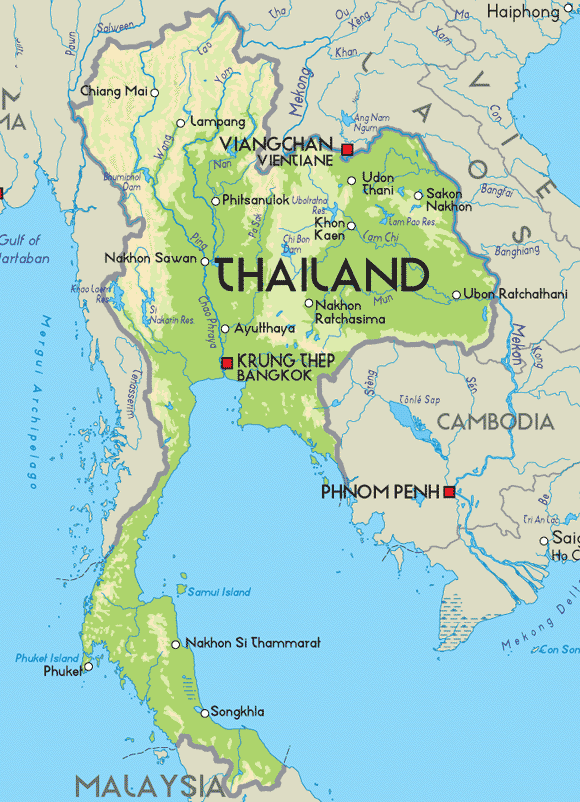<· Thailand
Situated in Southeast Asia, Thailand is predominantly a Buddhist kingdom almost equidistant from India and China. Known by outsiders as Siam for centuries, Thailand (the land of smiles), has been something of a Southeast Asian migratory, cultural, and religious crossroads.
- Approximately the size of France, Thailand covers and area of 510,000 sq. km and has a population of 60 million growing at a rate of 1.5% each year. Thailand shares its border with Myanmar in the west and north, Laos in the northeast, Cambodia in the east and Malaysia in the south.
- Administratively, the country is divided into 7 regions: The North, Northeast, Central Plains, East, West, and the Bangkok Metropolitan Region. Each of which has its own distinctive geographical character.
- The central region, encompassing the Bangkok metropolitan region and the central plains, is affectionately known as "Thailand's Rice Bowl". One of the world's most fertile rice and fruit growing areas, this is the economic and cultural heartland of the Thai nation.
- The mountainous north is Thailand's largest region. Here, elephants work the forest and winter temperatures are sufficiently cool to permit cultivation of temperate fruits such as strawberries and peaches.
- The second largest and poorest region is the sprawling northeast. Better known as "Isan" or the "Khorat Plateau", it is largely bordered by the Mekong River, where the world's oldest Bronze Age civilization flourished some 5,000 years ago.
- Just south of the northeast lies the eastern region. Sandwiched between the sea and the Damrek range, this is where pristine beaches support the growth of summer resorts such as Pattaya.
- Despite recent development efforts undertaken by the government in the west, its beautiful mountains, which rise up towards the Burmese border and its lush valleys remain relatively unspoiled. The towns here have a frontier atmosphere.
- Last but not least, the peninsular south. Here, arresting scenic beauty complements the economically vital activities of tin mining, rubber cultivation, and fishing.
LOCATIONS, GEOGRAPHY AND CLIMATE IN THAILAND
- Thailand is the geographical heart of South-East Asia. The infamous golden triangle, located at the nation's northernmost point, is where Thailand's borders meet those of both Laos and Myanmar (Burma). The border with Myanmar continues to the west and then south as far as the Malay peninsula, much of which is occupied by Thailand. On the east, the border with Laos meanders southeast along the Mekong River until it reaches Cambodia, which is due east of Bangkok, the Thai Capital. In the south is the Gulf of Thailand. Roughly the size of France (200,000 sq. miles), Thailand is composed of four main regions. The northern mountainous region contains numerous ruins and temples, the ancient city of Chieng Mai, and Thailand's highest peak, Doi Inthanon. This region is also home to the hill tribes of Thailand, distinct ethnic groups which settled in the area thousands of years ago after migrating from as far away as Tibet and central China. The north-east of Thailand occupies the semi-arid Korat plateau, the most desolate and least-visited part of the country. An interesting blend of Thai, Lao, and Khmer influences characterise the culture of the Korat. Central Thailand, which consists of the fertile plains surrounding the Chao Phraya River, is the country's most populous region and its rice basket. Thailand's alluring and congested capital city of Bangkok is located along the banks of the Chao Phraya, near the river's outlet into the Bight of Bangkok and the Gulf of Thailand. The southern region of Thailand, which stretches for hundreds of miles along the Malay peninsula, abounds with stunning beaches and scores of tropical islands.
- Thailand can be an extremely hot and soggy place. Its tropical climate is divided into three seasons: cool in November to February, hot in March to May, and rainy in June to October. The seasons are more extreme in the northern regions, where the dry heat can grow quite intense in late spring and the cool can become cold in the mountains. The rainy season is no detriment to travel in Thailand, as the rains can be cool and refreshing.


No comments:
Post a Comment